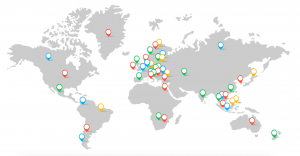
As a nonprofit, exposure to a wide audience is huge. But that can be costly and time consuming. Little known to many nonprofits, there's an opportunity to shine online: a $10,000 monthly Google AdWords grant.
 image from Google Ad Grants
image from Google Ad Grants
Using this AdWords grant, nonprofits can get more visibility to their cause. And that means more donations, a bigger pool of volunteers, and a larger community invigorated to make a difference.
The grant makes it easy for nonprofits to set up an AdWords campaign. And then, you can access Google Analytics and conversion tracking to see how ads perform: The complete toolkit to improve your ads over time.
If you qualify, Google offers you a choice between AdWords Express — which automatically manages your ads — or AdWords, in which you can manage the campaign yourself.
If free exposure sounds good to you, then check out our tips to get selected, below.
Google offers grants to over 20,000 nonprofits in more than 50 countries.
The program has no apparent limits. But still, there are some qualifications and best practices you should follow to be selected.
In order to qualify, first, your nonprofit must be located in one of 50 pre-selected countries.
 A list of countries eligible for Google's nonprofit grants; available at Google.com/grants/eligibility
A list of countries eligible for Google's nonprofit grants; available at Google.com/grants/eligibility
Second, your nonprofit must be a charitable organization in good standing with your country. Nonprofits must be registered with the local TechSoup partner, and receive validation as a nonprofit. (It should be noted that schools, academic institutions, government organizations, hospitals, and healthcare organizations are not eligible.)
Third, your nonprofit must hold a valid charity status. This requirement can vary per country.
And, finally, you must agree to Google’s terms. These basically state that you don't discriminate, and also that you use donations appropriately. There are also ongoing eligibility requirements you'll need to meet.
As another, more vague, guideline, Google requests that nonprofits provide “substantial content.”
What does this mean for your nonprofit? Content is important not only for Google’s approval, but also to engage the audience that clicks on the ad.
Yet creating content for nonprofit marketing can be a challenge. You're strained for time and resources. And you must find a way to inform, educate, inspire, and engage visitors all on your website.
Here are some best practices to get the most out of great nonprofit ads and content.
If you target a variety of audiences — volunteers, donors of all levels, partners, and advocates — your net will be cast too large. Therefore, use audience targeting to your advantage.
 Segmented ads are more specific, and therefore more compelling. So instead of advertising your nonprofit to everyone, be specific with your grant. For example, launch a volunteer campaign targeted to local university students, or a pet adoption geared towards people with children who would like a family pet.
Segmented ads are more specific, and therefore more compelling. So instead of advertising your nonprofit to everyone, be specific with your grant. For example, launch a volunteer campaign targeted to local university students, or a pet adoption geared towards people with children who would like a family pet.
The more specific your ad and its audience, the more clicks you'll get. And that will drive down your cost-per-click, meaning your money will go farther to reach more people.
Once people click your targeted ad, don't send them somewhere vague, like your home page. Instead, set up customized landing pages for each campaign topic.
A designated landing page should offer more information (like bullet points), present some visuals (like photos or infographics), and provide an impact statement — "Your donation/volunteering/advocacy will go ____ [this far!]."
Include a form to capture information, and a clear call-to-action with compelling language. "Feed a hungry child!" is more captivating than "Submit," for example.
Your design will be important, too:
Nearly 49% of Google AdWords clicks come from a mobile phone. – DMR
Therefore, make sure your website (at very least, your landing page) is mobile optimized, so it doesn't drive any potential engagements away.
Also, consider creating interactive "impact" graphics that will show how far a donation or volunteer session will go:

Your website shouldn't be a static brochure site. Google gives preference in search to websites with plenty of helpful content. So, our best guess is that it also gives these grants to nonprofits with a strong content presence.
Content can include case studies, impact stories, infographics, blog posts, and more.
82% of people feel more positive about an organization after reading custom content. – Demand Metric
Create content regularly and update your site to keep it fresh. Not only will this increase your chances of receiving a grant — but you will also keep your Ad traffic engaged and committed to helping your organization.
With the right plan in place, you will get the most out of your Google AdWords Grant, and make the most impact.
Sources
https://www.google.com/grants/
https://www.google.com/grants/eligibility/
M+R. (2016). Benchmarks 2016. https://mrbenchmarks.com/
contentmarketinginstitute.com/2015/03/buy-in-conversation-content-marketing/
expandedramblings.com/index.php/google-advertising-statistics/
by Jonathan Franchell, CEO of Ironpaper - For more tips and hacks: Need to remove a new line after h1 tags? Both web designers and SEO practitioners need to employ headline tags: H1, H2, H3 in several ways to improve web page structure and tag...

The marketing industry is transforming significantly due to generative AI and increasing market complexity. Gartner's prediction of a 25% decline in traditional search traffic suggests that the era of search engines is dying. AI tools, particularly...

The Crowded Arena of the IT Marketplace Updated December 2024 The Information Technology (IT) landscape is experiencing rapid growth and intensifying competition. IT spending is projected to reach nearly 5.1 trillion U.S. dollars in 2024, a...

Updated December, 2024 The field of digital marketing is evolving rapidly in response to new technology and changing buyer expectations. To help career-minded marketers, we’ve rounded up the top 10 skills needed to succeed in the field. These are...
